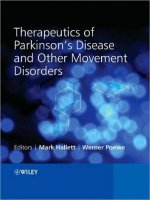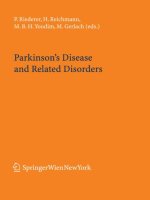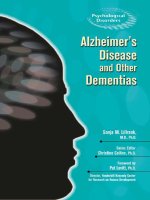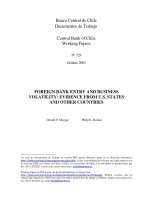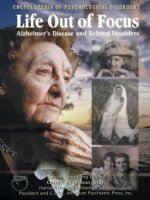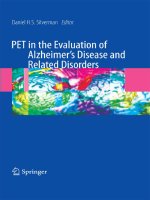The Handbook of Alzheimer’s Disease and Other Dementias doc
Bạn đang xem bản rút gọn của tài liệu. Xem và tải ngay bản đầy đủ của tài liệu tại đây (6.35 MB, 664 trang )
The Handbook of Alzheimer’s Disease and
Other Dementias
Wiley - Blackwell Handbooks of Behavioral Neuroscience
The rapidly expanding fi eld of behavioral neuroscience examines neurobiological
aspects of behavior, utilizing techniques from molecular biology, neuropsychol-
ogy, and psychology. This series of handbooks provides a cutting - edge overview
of classic research, current scholarship, and future trends in behavioral neuro-
science. The series provides a survey of representative topics in this fi eld, suggest-
ing implications for basic research and clinical applications.
Series editor: David Mostofsky, Boston University
The Handbook of Stress: Neuropsychological Effects on the Brain
Edited by Cheryl D. Conrad
The Handbook of Alzheimer ’ s Disease and Other Dementias
Edited by Andrew E. Budson and Neil W. Kowall
The Handbook of the Neuropsychology of Language (2 Volumes)
Edited by Miriam Faust
The Handbook of
Alzheimer’s
Disease and Other
Dementias
Edited by Andrew E. Budson and
Neil W. Kowall
A John Wiley & Sons, Ltd., Publication
This edition fi rst published 2011
© 2011 Blackwell Publishing Ltd.
Blackwell Publishing was acquired by John Wiley & Sons in February 2007. Blackwell’s publishing program
has been merged with Wiley’s global Scientifi c, Technical, and Medical business to form Wiley-Blackwell.
Registered Offi ce
John Wiley & Sons Ltd, The Atrium, Southern Gate, Chichester, West Sussex, PO19 8SQ, UK
Editorial Offi ces
350 Main Street, Malden, MA 02148-5020, USA
9600 Garsington Road, Oxford, OX4 2DQ, UK
The Atrium, Southern Gate, Chichester, West Sussex, PO19 8SQ, UK
For details of our global editorial offi ces, for customer services, and for information about how to apply
for permission to reuse the copyright material in this book please see our website at www.wiley.
com/wiley-blackwell.
The right of Andrew E. Budson and Neil W. Kowall to be identifi ed as the editors of the editorial material
in this work has been asserted in accordance with the UK Copyright, Designs and Patents Act 1988.
All rights reserved. No part of this publication may be reproduced, stored in a retrieval system, or
transmitted, in any form or by any means, electronic, mechanical, photocopying, recording or otherwise,
except as permitted by the UK Copyright, Designs and Patents Act 1988, without the prior permission of
the publisher.
Wiley also publishes its books in a variety of electronic formats. Some content that appears in print may
not be available in electronic books.
Designations used by companies to distinguish their products are often claimed as trademarks. All brand
names and product names used in this book are trade names, service marks, trademarks or registered
trademarks of their respective owners. The publisher is not associated with any product or vendor
mentioned in this book. This publication is designed to provide accurate and authoritative information in
regard to the subject matter covered. It is sold on the understanding that the publisher is not engaged in
rendering professional services. If professional advice or other expert assistance is required, the services of a
competent professional should be sought.
Library of Congress Cataloging-in-Publication Data
The handbook of Alzheimer’s disease and other dementias / edited by Andrew E.
Budson and Neil W. Kowall.
p. ; cm. – (Wiley-Blackwell handbooks of behavioral neuroscience)
Includes bibliographical references and index.
ISBN 978-1-4051-6828-1 (hardcover : alk. paper)
1. Dementia. I. Budson, Andrew E. II. Kowall, Neil W. III. Series:
Wiley-Blackwell handbooks of behavioral neuroscience.
[DNLM: 1. Dementia. WM 220]
RC521.H34 2011
616.8'3–dc22
2011010575
A catalogue record for this book is available from the British Library.
This book is published in the following electronic formats: ePDFs 9781444344080;
Wiley Online Library 9781444344103; ePub 9781444344097
Set in 10.5/13 pt Minion by Toppan Best-set Premedia Limited
1 2011
We wish to dedicate this book to our families:
Amy, Leah, and Danny
And
Miriam, Elisheva, Charlotte, Jenny, Mischa, and Jonah
Contents
Contributors ix
Foreword xii
Preface xv
Part I Common Dementias 1
1 Alzheimer’s Disease 3
Alan M. Mandell and Robert C. Green
2 Vascular Dementia 92
Angela L. Jefferson, Amanda M. Gentile, and Ravi Kahlon
3 Dementia with Lewy Bodies 131
Tamara G. Fong and Daniel Z. Press
4 Frontotemporal Dementia 145
Adam L. Boxer
5 Other Dementias 179
Peter Morin
Part II Pathogenesis and Disease Mechanisms 195
6 Genetic Risk Factors for Dementia 197
Paul Hollingworth and Julie Williams
7 The Neuropathology of the Dementing Disorders 235
Ann C. McKee and Brandon E. Gavett
8 Amyloid Beta Peptide and the Amyloid Cascade Hypothesis 262
Carmela R. Abraham
viii Contents
9 Other Mechanisms of Neurodegeneration 277
Marina Boziki, Vassilis Papaliagkas, and Magda Tsolaki
10 Rational Therapeutics for Alzheimer’s Disease and Other Dementias 301
Neil W. Kowall
Part III Cognitive and Behavioral Dysfunction 313
11 Memory Dysfunction in Dementia 315
Andrew E. Budson
12 Language Processing in Dementia 336
Jamie Reilly, Joshua Troche, and Murray Grossman
13 Executive Functioning 369
Robert A. Stern, Stacy L. Andersen, and Brandon E. Gavett
14 Emotion and Behavior in Alzheimer’s Disease and Other Dementias 416
Christopher I. Wright
15 Visuospatial Function in Alzheimer’s Disease and Related Disorders 457
Alice Cronin-Golomb
16 Sleep and Circadian Rhythms in Dementia 483
David G. Harper
Part IV Neuroimaging in Dementia 505
17 Glimpses of the Living Brain with Alzheimer’s Disease 507
Ronald J. Killiany
18 Functional MRI in Alzheimer’s Disease and Other Dementias 535
Maija Pihlajamäki and Reisa A. Sperling
19 Molecular Neuroimaging of the Dementias 557
Bradford C. Dickerson
20 Using EEG and MEG to Understand Brain Physiology in
Alzheimer’s Disease and Related Dementias 575
Brandon A. Ally
Index 604
Contributors
Carmela R. Abraham Department of Biochemistry & Alzheimer ’ s Disease Center,
Boston University School of Medicine, Boston, MA, USA
Brandon A. Ally Departments of Neurology, Psychiatry, and Psychology,
Vanderbilt University, Nashville, TN, USA
Stacy L. Andersen New England Centenarian Study, Boston University School of
Medicine, Boston, MA USA
Adam L. Boxer Memory and Aging Center, Department of Neurology, University
of California, San Francisco, CA, USA
Marina Boziki 3rd Department of Neurology, Aristotle University of Thessa-
loniki, Greece
Andrew E. Budson Department of Neurology & Alzheimer ’ s Disease Center,
Boston University School of Medicine, Boston, MA, USA; Center for Translational
Cognitive Neuroscience and Geriatric Research Education Clinical Center, VA
Boston Healthcare System, Boston, MA, USA; Memory Disorders Unit, Division of
Cognitive and Behavioral Neurology, Department of Neurology, Brigham &
Women ’ s Hospital, Boston, MA, USA; Harvard Medical School, Boston, MA, USA
Alice Cronin - Golomb Department of Psychology, Boston University, Boston,
MA, USA
Bradford C. Dickerson Department of Neurology, Athinoula A. Martinos Center
for Biomedical Imaging, and the Alzheimer ’ s Disease Research Center, Massachusetts
General Hospital, Boston, MA, USA; Memory Disorders Unit, Division of Cognitive
and Behavioral Neurology, Department of Neurology, Brigham & Women ’ s Hospital,
Boston, MA, USA; Harvard Medical School, Boston, MA, USA
Tamara G. Fong Aging Brain Center, Hebrew SeniorLife, Boston, MA. USA;
Department of Neurology, Beth Israel Deaconess Medical Center, Boston, MA. USA;
Harvard Medical School, Boston, MA. USA
x Contributors
Brandon E. Gavett Department of Neurology & Alzheimer ’ s Disease Center,
Boston University School of Medicine, Boston, MA, USA
Amanda M. Gentile Department of Neurology & Alzheimer ’ s Disease Center,
Boston University School of Medicine, Boston, MA, USA
Robert C. Green Division of Genetics, Department of Medicine, Brigham and
Women ’ s Hospital, Boston, MA. USA; Harvard Medical School, Boston, MA. USA
Murray Grossman Department of Neurology, University of Pennsylvania School
of Medicine, Philadelphia, PA, USA
David G. Harper Department of Psychiatry, Harvard Medical School, Boston,
MA, USA; Department of Psychology, McLean Hospital, Belmont, MA, USA
Paul Hollingworth Medical Research Council (MRC) Centre for Neuropsychi-
atric Genetics and Genomics, Department of Psychological Medicine and Neurology,
School of Medicine, Cardiff University, Cardiff, UK
Angela L. Jefferson Department of Neurology & Alzheimer ’ s Disease Center,
Boston University School of Medicine, Boston, MA, USA
Ravi Kahlon Department of Neurology & Alzheimer ’ s Disease Center, Boston
University School of Medicine, Boston, MA, USA
Ronald J. Killiany Department of Anatomy and Neurobiology, Laboratory for
Cognitive Neurobiology, Center for Biomedical Imaging, Boston University School
of Medicine, Boston, MA, USA
Neil W. Kowall Departments of Neurology and Pathology & Alzheimer ’ s Disease
Center, Boston University School of Medicine, Boston, MA, USA; Neurology Service
and Geriatric Research Education Clinical Center, VA Boston Healthcare System,
Boston, MA, USA; Harvard Medical School, Boston, MA, USA
Alan M. Mandell Departments of Neurology and Psychiatry, and Alzheimer ’ s
Disease Center, Boston University School of Medicine, Boston, MA, USA; Geriatric
Research Education Clinical Center, Bedford VA Hospital, Bedford, MA, USA
Ann C. McKee Departments of Neurology and Pathology, Alzheimer ’ s Disease
Center, Boston University School of Medicine, Boston, MA, USA; Geriatric Research
Education Clinical Center, Bedford VA Hospital, Bedford, MA, USA
Peter J. Morin Department of Neurology & Alzheimer ’ s Disease Center, Boston
University School of Medicine, Boston, MA, USA; Geriatric Research Education
Clinical Center, Bedford VA Hospital, Bedford, MA, USA
Vassilis Papaliagkas 3rd Department of Neurology, Aristotle University of
Thessaloniki, Greece
Maija Pihlajam ä ki Department of Neurology, Kuopio University Hospital,
Kuopio, Finland
Contributors xi
Daniel Z. Press Department of Neurology, Beth Israel Deaconess Medical Center,
Boston, MA, USA; Harvard Medical School, Boston, MA, USA
Jamie Reilly Department of Speech, Language, and Hearing Sciences, University
of Florida, Gainesville, FL, USA
Reisa A. Sperling Department of Neurology, Brigham and Women ’ s Hospital,
Boston, MA, USA; Harvard Medical School, Boston, MA, USA
Robert A. Stern Department of Neurology & Alzheimer ’ s Disease Center, Boston
University School of Medicine, Boston, MA, USA
Joshua Troche Department of Speech, Language, and Hearing Sciences, University
of Florida, Gainesville, FL, USA
Magda Tsolaki 3rd Department of Neurology, Aristotle University of Thessa-
loniki, Greece
Julie Williams Medical Research Council (MRC) Centre for Neuropsychiatric
Genetics and Genomics, Department of Psychological Medicine and Neurology,
School of Medicine, Cardiff University, Cardiff, UK
Christopher I. Wright Laboratory of Aging and Emotion, Department of
Psychiatry, Athinoula A. Martinos Center for Biomedical Imaging, Massachusetts
General Hospital, Charlestown, MA, USA; Division of Cognitive and Behavioral
Neurology, Department of Neurology, Brigham and Women ’ s Hospital, Boston,
MA, USA; Harvard Medical School, Boston, MA, USA
F o r e w o r d
In 1903, Emil Kraeplin recruited Alois Alzheimer to join his department at the
Nervenklinik in Munich. Kraeplin challenged Alzheimer, who was known for his
clinical and pathological research, to uncover the biological basis of mental illness.
In 1906, Alzheimer hit pay dirt, when he described the neuritic plaques and neu-
rofi brillary tangles in the brain of Auguste D., his 53 - year - old patient with dementia.
Alzheimer ’ s presentation at the 37th Assembly of Southwest German Psychiatrists
in Tubingen apparently generated very little interest from the attendees, who
included such prominent fi gures as Nissl, Jung, and Binswanger; the Tubinger
Chronik newspaper carried a single line on the case in reporting the meeting.
Kraeplin ’ s infl uential textbook eventually accepted this condition of pre - senile
dementia and proposed the name Alzheimer ’ s disease. Growing from this single case
report, Alzheimer ’ s disease is now widely recognized as one of the most common
neurological diseases, but it was not always so.
Between 1906 and 1966, there was very little clinical or research interest in
Alzheimer ’ s disease as it was widely viewed as a rare form of pre - senile dementia.
Neurology textbooks rarely allotted it more than a page or two, there were only a
handful of papers published in the literature, and almost nothing heard at the
annual neurology meetings.
Interest began to pick up with Sir Martin Roth ’ s report in 1966 that neuritic
plaques occurred in brains of the elderly, and that their number roughly correlated
with the extent of dementia severity. In 1976, Robert Katzman ’ s seminal article on
the epidemiology of Alzheimer ’ s disease stressed that pre - senile and senile demen-
tia were similar pathologically. His conclusion that we faced a silent epidemic of
staggering proportions was a stunning wake - up call to action. Three other events
occurred in the 1970s that catalyzed the modern era wave of clinical and scientifi c
research into the causes, mechanisms, and treatment of Alzheimer ’ s disease and
related dementias. The fi rst of these was establishing the National Institute on
Aging at the National Institutes of Health, and the strategic plan for Alzheimer ’ s
Foreword xiii
disease under the direction of the Institute ’ s fi rst director, Robert Butler and the
associate director Zaven Khachaturian. This Institute cast Alzheimer ’ s disease as a
priority on the national health stage, and provided federal funds for research. The
second important step was led by Jerry Stone, who founded the Alzheimer ’ s Disease
and Related Disorders Association (now renamed the Alzheimer ’ s Association).
This private foundation spread from its base in Chicago to establish chapters across
the country dedicated to raising awareness about Alzheimer ’ s disease and raising
money to support research. The third event was a scientifi c breakthrough: Indices
of acetylcholine metabolism, a neurotransmitter in the brain linked to memory
capacities, were decreased in brains of patients with Alzheimer ’ s disease. This
advance was crucial because it opened a new approach to Alzheimer ’ s disease that
justifi ed expenditure of public and private dollars for research. Further, this discov-
ery sparked hope for a cure because drugs can be developed that alter the neuro-
chemical milieu of the brain, whereas the anatomic pathological features of
Alzheimer ’ s disease – the neuritic plaques and tangles – have always seemed immu-
tably fi xed. Indeed, this discovery paved the way for developing acetylcholinesterase
inhibitors, the fi rst class of drugs approved by the FDA for treating Alzheimer ’ s
disease. In 1984, the fi rst clinical criteria for the diagnosis of Alzheimer ’ s disease
was published, and the fi rst fi ve Alzheimer ’ s Disease Research Centers were estab-
lished with funding from the National Institute on Aging. These Centers, which
now number 30 across the United States, are the focal point for much of the clinical
and scientifi c research conducted on Alzheimer ’ s disease. This volume highlights
many of the advances generated by investigators in these Centers and underscores
the multidisciplinary approach in clinical science that is the hallmark of modern
dementia research.
Alzheimer ’ s disease is the most prevalent cause of dementia, but not the only
cause. Dementia due to multiple strokes has always been appreciated, but clinicians
now routinely diagnose degenerative conditions such as frontal temporal dementia
and diffuse Lewy body disease that were previously lumped with Alzheimer ’ s
disease. As pointed out in chapters of this volume, these related neurodegenerative
diseases have clinical and neuropsychological features that aid in the diagnosis and
that distinguish them from Alzheimer ’ s disease. In this sense, the fi eld of cognitive
neuroscience has improved the diagnosis of dementia syndromes; in turn, the study
of neurodegenerative diseases has helped boost neuropsychological research.
Neuroimaging also helps distinguish Alzheimer ’ s disease, frontal temporal demen-
tia, and dementia with Lewy bodies, as brain scans in each of these conditions
have a typical anatomic, functional and molecular signature. Their separate identi-
ties are reinforced by neuropathological fi ndings that confi rm the clinical
diagnoses, and that also drive scientifi c research into the causes of each disease.
Advances in this area now permit molecular classifi cation of diseases due to accu-
mulation of misfolded proteins in brain that are distinctive for each condition.
Thus, we speak of Alzheimer ’ s disease as an “ amyloidopathy ” ; some cases of frontal
temporal dementia as a “ tauopathy ” ; and dementia with Lewy bodies as an “ alpha -
syncleinopathy. ” Uncovering the molecular signature of these diseases is as
xiv Foreword
important to the fi eld now as the discovery of acetylcholine defi ciency was in the
1970s, as research into the cellular mechanisms leading to accumulation of toxic
protein fragments may hold the key to developing protective and even curative
therapies.
John H. Growdon, M.D.
Professor of Neurology, Harvard Medical School
Massachusetts Alzheimer ’ s Disease Research Center
Massachusetts General Hospital, Boston, MA USA
P r e f a c e
This book provides a comprehensive review of Alzheimer ’ s disease and other
dementias from both basic and clinical neuroscience perspectives. Scientists and
medical professionals will fi nd both a broad introduction and an up - to - date review
of important scientifi c advances in a single volume. Those working in the areas of
Alzheimer ’ s disease and dementia will fi nd this book of interest, including physi-
cians, medical students, psychologists, scientists, graduate students, and allied health
professionals including nurses, social workers, and therapists. Part I, “ Common
Dementias, ” is designed to provide an overview of Alzheimer ’ s disease and other
dementias including a brief discussion of pathology, pathophysiology, clinical mani-
festations, diagnosis, and treatment. It also provides background for later chapters.
Part II, “ Pathogenesis and Disease Mechanisms, ” provides an update on the current
genetic risk factors and pathophysiological mechanisms related to dementia. Part
III, “ Cognitive and Behavioral Dysfunction, ” reviews the disruption of different
cognitive and other functions, including emotion and sleep. Part IV, “ Neuroimaging
in Dementia, ” provides an update on this exciting and fast - paced fi eld. The book is
designed such that readers can either peruse a chapter of interest or read the book
cover to cover. In either case, we believe that you will fi nd this book a useful tool
for school, research, or clinical practice.
We would like to thank all of our authors for their excellent contributions and
the series editor Professor Mostofsky for his constant encouragement. It is they who
deserve the credit for the value in this book; any errors contained herein are our
fault alone. Lastly, we would like to note that this book was completed entirely on
our own time, during late nights, early mornings, weekends, and vacations.
Andrew E. Budson and Neil W. Kowall
Boston MA
Acknowledgments : Preparation of this book was supported, in part, by P30 -
AG13846 (Boston University Alzheimer ’ s Disease Core Center) and the Department
of Veterans Affairs GRECC program and Research Service.
P a r t I
Common Dementias
1
Alzheimer ’ s Disease
Alan M. Mandell and Robert C. Green
History
In 1871, over 30 years before Alois Alzheimer published his seminal cases, James
Crichton - Browne may have been among the fi rst physicians to remark upon the
relationship between “ brain wasting ” and “ premature dotage ” in a letter to Charles
Darwin (Snyder & Pearn, 2007 ). Age - related mental deterioration as an entity had
been recognized virtually for recorded history (Boller et al., 2007 ; Mandell & Albert,
1990 ). Emil Kraepelin, however, was one of the few 19th - century giants of medicine
who recognized the connection between brain pathology and mental dissolution in
the elderly (Stam, 1985 ). He referred to “ Morbus Alzheimer ” as early as 1908 and
used the eponym in the 1910 edition of his textbook (Kraepelin, 1910 ). Over the
next century plus, Alzheimer ’ s disease (AD) has become the focus of one of the
most intensive investigations in medical history. A Google search for AD now gener-
ates over 18 million hits.
Alzheimer examined 51 - year - old Auguste D. in 1901 (Graeber, 2006 ). Her
husband had noted a relatively sudden change in her behavior, dominated by panic,
terror and suspicions of his having an affair with a neighbor. She neglected her
housework, hid objects and fumbled in the kitchen. Over the next several months,
she became increasingly restless and a disturbance to their neighbors. By the time
of her admission to hospital, which she never left, she suffered from “ weakening of
memory, persecution mania, sleeplessness, restlessness, ” had an “ amnestic writing
disorder, ” was unable to perform any mental or physical work and was “ rarely free
from fear and agitation. ” Periods of calm cooperation alternated with physical
aggression towards other patients, “ groping their faces as if she were blind ” (Page
& Fletcher, 2006 ).
Alzheimer was met with silence when he fi rst presented his case (Alzheimer, 1906 )
of “ a distinct disease process ” (Nair & Green, 2006 ). Following his initial publication
The Handbook of Alzheimer’s Disease and Other Dementias, First Edition.
Edited by Andrew E. Budson, Neil W. Kowall.
© 2011 Blackwell Publishing Ltd. Published 2011 by Blackwell Publishing Ltd.
4 Alan M. Mandell and Robert C. Green
of 1907 (Alzheimer, 1907 ), he issued his classic review article in 1911 (Alzheimer,
1911 ).
With a few exceptions and for several reasons (Nair & Green, 2006 ), “ Alzheimer ’ s
disease ” for roughly the next 50 years denoted “ presenile ” dementia and differed
from the “ normal ” senility associated with old age, despite Alzheimer ’ s assertion
that there were no signifi cant pathological differences between older and younger
cases (Spielmeyer, 1916 ). Kraepelin as well opined that this illness is “ a peculiar
disease process that is largely independent of age ” (Kraepelin, 1910 ).
Alzheimer described the now familiar distinctive pathology in his original 1907
article. Slides from two patients were rediscovered in 1992 and 1997, and those from
Auguste D. clearly demonstrate numerous characteristic cortical plaques and tangles
(Graeber, 2006 ).
Epidemiology of Dementia and AD
In virtually all developed countries, the oldest segments of society are increasing at
the fastest rate and an epidemic of age - related diseases is already upon us. The
dementia syndrome is largely a provenance of the elderly and is a major part of a
looming public health crisis. The global prevalence of dementia of any cause in 2005
was about 24 million with yearly incidence of almost 5 million, tantamount to
adding a new case every 7 seconds (Ferri et al., 2005 ).
AD accounts for about 55 – 70% of adult - onset dementia in the industrialized
world (Lim et al., 1999 ), is the fi fth leading cause of death in Americans older than
65, and, in contrast to the decreasing death toll attributable to other major diseases,
that due to AD is on the rise (Mebane - Sims & Alzheimer ’ s Association, 2009 )
(Figure 1.1 ).
Figure 1.1 Population - based vs. clinic - based estimates of dementia
Source: Modifi ed from Green, R.C. (2005) . Diagnosis and Management of Alzheimer ’ s Disease
and Other Dementias (2nd edn.). Caddo, OK: Professional Communications, Inc., by
permission
Alzheimer’s disease (AD)
Vascular dementias
(VAD) + AD
VAD
Lewy body
dementias (LBD)
Frontal-lobe dementias
(FLD)/ other degenerative
dementias
Depression, tumor,
hydrocephalus, metabolic
disorders, and other
potentially reversible
dementias
C
l
i
n
i
c
-
B
a
s
e
d
E
s
t
i
m
a
t
e
s
P
o
p
u
l
a
t
i
o
n
-
B
a
s
e
d
E
s
t
i
m
a
t
e
s
Alzheimer’s Disease 5
AD incidence is age related and doubles about every 5 years from age 65 through
the 90s (Bachman et al., 1993 ; Berlau, 2007 ). The exact prevalence of AD is diffi cult
to determine because, among other reasons, death certifi cates of people with end -
stage AD often list infection or “ cardiopulmonary arrest ” as the proximate cause.
Currently, over 5 million Americans have AD with incidence of a new case about
every 70 seconds. In the United States, there will be at least 8.5 million people with
AD by the year 2030, about 13 to 25 million in 2050 (a new case every 33 seconds)
(Hebert et al., 2003 ; Mebane - Sims & Alzheimer ’ s Association, 2009 ) plus an
unknown number with other dementias. National direct and indirect monetary
costs of caring for people with Alzheimer ’ s disease alone is already at least $100
billion annually in the United States (Koppel, 2003 ), where nursing home cost per
patient currently hovers around $50,000 per year, and over $300 billion per annum
globally (Dartigues, 2009 ). We therefore need hardly emphasize the current and
growing economic impact of AD, the “ coming plague of the 21st century, ” on health
systems worldwide. More specifi c epidemiological data are discussed in this and
other chapters.
Dementia
D e fi nition, e valuation, m anagement, and t reatment
Symptoms common to most dementias include forgetfulness, language deteriora-
tion, mood changes, impaired judgment, and loss of initiative. There is nevertheless
no universally accepted defi nition of “ dementia, ” which has been broadly character-
ized as a syndrome, as shorthand for unsuccessful aging, and as a specifi c diagnosis
(Green, 2005 ), that is, as a synonym for AD. Within its multitude of defi nitions,
diagnostic criteria have routinely included memory impairment, decline in social
or occupational function (American Psychiatric Association, 2000 ), progressive
deterioration, incurability, and irreversibility. Clinicians must nevertheless be aware
that pathological processes underlying many causes of dementia are static and that
a few are treatable. Furthermore, while the association between dementia and
memory disorder is almost ubiquitous, signifi cant amnesia is not a salient feature
of every dementing disease. Evidence of functional decline , e.g., in personal hygiene,
bill paying, housecleaning, personality, etc., is, at least for research purposes, cur-
rently the clinical marker separating “ possible dementia ” and “ normal aging ” from
“ dementia. ” Many factors can nevertheless mask or delay occupational or social
incompetence and we favor a somewhat broader defi nition.
“ Dementia, ” as used in this chapter, is a syndrome of acquired persistent intel-
lectual impairments characterized by deterioration in at least three of the following
domains: memory, language, visuospatial skills, personality or behavior, and manip-
ulation of acquired knowledge (including executive function) (Cummings, 2004 ;
Cummings & Benson, 1992 ; Cummings & Mega, 2003 ). According to this defi nition,
mental retardation and acute confusional states (ACS; delirium) do not qualify, the
6 Alan M. Mandell and Robert C. Green
former because it is not acquired, the latter because multiple cognitive impairments
associated with it by defi nition are temporary (see subsequent discussion of the
ACS). The presence of a dementia is supported by a combination of a carefully
obtained history, physical and mental status examinations, signifi cant impairment
on neuropsychological tests corrected for age and education, and a change in test
scores over a 6 – 12 - month interval (Mesulam, 2000 ).
This defi nition, like all the others, is not perfect. Persons with superior pre -
morbid intellect and greater cognitive reserve (Roe et al., 2007 ) may suffer decline
in occupational performance which nevertheless escapes even the most detailed
clinical assessment and which results in no other objective functional impairment
(Cummings, 2005a ; Strub & Black, 2000 ). Some ultimately dementing disorders
(Benson et al., 1988 ; Dubois et al., 2007 ; Mesulam, 2003 ) may manifest for years as
gradual deterioration limited to a single cognitive domain which in turn can infl u-
ence execution and interpretation of other cognitive functions (Mesulam, 2000 ).
“ Dementia of the Alzheimer type ” (DAT) refers to the clinical syndrome which by
far is that most commonly associated with autopsy - proven ( pathologic ) AD.
Recognition and d ifferential d iagnosis of the d ementia s yndrome
Management and treatment of dementia begins with its recognition, which is rea-
sonably straightforward either when the patient or an independent historian
expressly raises cognitive (or behavioral) deterioration as an issue, or it becomes
obvious in context with other medical issues (e.g., following hospital admission).
Recognition is a not inconsiderable concern, however, because cognition and behav-
ior are indeed not issues for many “ community dwelling elderly ” who are neverthe-
less already demented and just one fall, infection, change of address or assault of a
spouse away from health system entry for these issues (Albert et al., 1991 ).
Recognition is further hindered because widespread neuropsychological testing,
imaging and laboratory screening for asymptomatic elderly people is not economi-
cally feasible. Furthermore, many health professionals as well as lay people persist
in believing that cognitive loss is an inevitable and “ natural ” consequence of aging
rather than a refl ection of brain damage. Although there is some longitudinal evi-
dence that general cognition “ normally ” recedes in a person ’ s mid - 70s (Brayne
et al., 1999 ), much of the decline previously attributed to age alone probably refl ects
the effect of mild unrecognized dementia. Studies of optimally healthy older adults
who are evaluated each year suggest that overall cognitive function may slow some-
what but does not refl ect a signifi cant longitudinal decline for these persons (Schaie,
1989 ). Therefore, in the absence of disease, older adults can reasonably expect stable
overall cognitive function and little or no interference with performance of everyday
activity (Rowe & Kahn, 1987 ). This requires a fundamental shift in the approach to
the aging patient, in that clinicians should not automatically attribute memory or
cognitive problems that interfere with everyday activities to normal aging, and this
should be communicated to the patient ’ s family.
Alzheimer’s Disease 7
Among adults over 85 years of age, the defi nition of “ normal ” cognition is much
more diffi cult to establish. Many neuropsychological tests have not been validated
for this group of the “ oldest old, ” and vision and hearing problems often interfere
with assessment. Apparently unimpaired individuals over 85 are nonetheless at high
risk of cognitive decline (Crystal et al., 2000 ; Howieson et al., 2003 ).
Most clinicians do not routinely test mental status in older individuals unless
they receive complaints either from the patient or the patient ’ s family. Many
demented patients do not, however, so - complain and, on average, most family
members do not seek medical attention for the patient until several years after onset
of symptoms (if the dementia is progressive). Most patients with DAT, therefore,
escape early diagnosis, particularly in primary care settings (Callahan et al., 1995 ;
Cummings, 2004 ; Cummings & Mega, 2003 ; Dartigues, 2009 ; Petrovitch et al.,
2001 ). Cognitive symptoms that are not associated with obvious functional impair-
ment may be dismissed or minimized.
The prevalence of truly curable dementia in the community has been debated
(Clarfi eld, 1995 ; Weytingh et al., 1995 ). The probability of fi nding a reversible cause
for dementia has nevertheless likely declined greatly in the past 20 years (Clarfi eld,
2003 ; Mok et al., 2004 ). Prompt recognition of dementia remains important all the
same because emerging diagnostic techniques and increasingly effective therapeutic
interventions are altering the defi nition of “ treatable ” (Fagan et al., 2007 ). Advantages
of an early - as - possible diagnosis of dementia are listed in Table 1.1 .
Differential d iagnosis of the d ementia s yndrome
Dementia is a syndrome of multiple possible causes. Like anemia, dementia is a
differential diagnostic, not a diagnostic term. In other words, even though AD
would for most demented persons be a correct diagnosis, the clinician should
systematically consider other disorders. Drugs (polypharmacy!), depression, and
Table 1.1 Advantages of early diagnosis in dementing conditions
For every case
• Provide a diagnostic answer and education for the patient and/or family
For patients with reversible or static diseases (e.g., depression, stroke)
• Relieve the fear of an irreversible or progressive disease
• Treat the underlying disease
• Initiate prevention and/or rehabilitation strategies
For patients with irreversible and progressive diseases (e.g., Alzheimer ’ s disease)
• Treat cognitive and behavioral symptoms
• Plan legal and fi nancial future while patient is still competent
• Initiate management strategies that will postpone dependence and institutionalization
Source: Green, R. C. (2005) . Diagnosis and management of Alzheimer ’ s disease and other dementias (2nd
edn.). Caddo, OK: Professional Communications. Professional Communications, Inc, by permission
